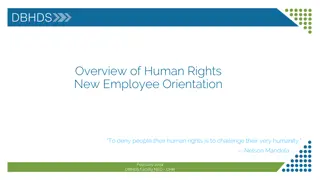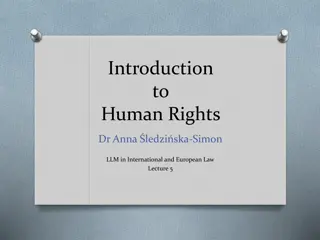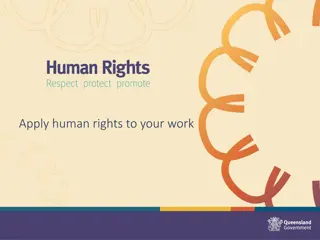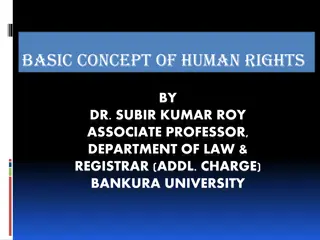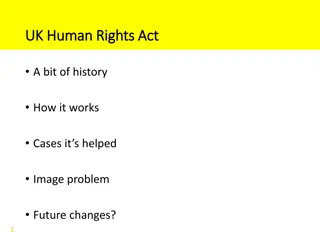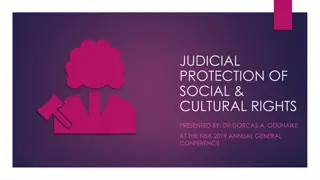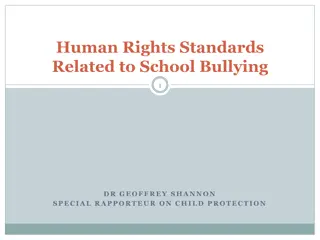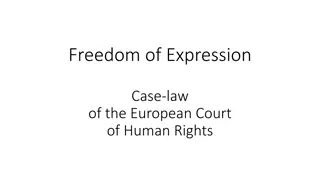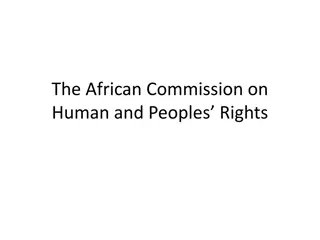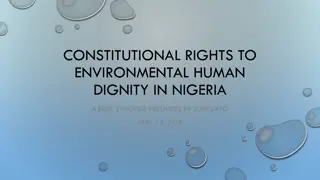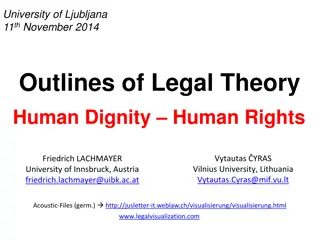Understanding National Human Rights Protection Systems
Explore the essential elements of national human rights protection systems including actors, frameworks, and processes. Learn about the foundational role of the state, legal frameworks, institutions, and the involvement of non-state actors in upholding human rights. Reflect on the importance of domestic normative frameworks and how they interplay with human rights-based approaches to development.
Download Presentation

Please find below an Image/Link to download the presentation.
The content on the website is provided AS IS for your information and personal use only. It may not be sold, licensed, or shared on other websites without obtaining consent from the author. Download presentation by click this link. If you encounter any issues during the download, it is possible that the publisher has removed the file from their server.
E N D
Presentation Transcript
NAME OF THE COURSE DATE NATIONAL HUMAN RIGHTS PROTECTION ACTORS, FRAMEWORK AND PROCESSES
LEARNING OBJECTIVES NATIONAL HUMAN RIGHTS PROTECTION * Participants understand the importance of grasping the plurality of actors within a national human rights system * Participants understand that there is a domestic normative framework that is instrumental when working with a HRBA to development * Participants reflect on how to link programming work to domestic actors and frameworks
NATIONAL HUMAN RIGHTS SYSTEM BASIS ESSENTIAL ELEMENTS (1) States must respect their human rights obligation Little guidance about exactly how states should do it Independent courts NHRI (Paris principles) Human rights focal points (UPR, CRPD)
NATIONAL HUMAN RIGHTS SYSTEM BASIS ESSENTIAL ELEMENTS (2) * UN: a national human rights protection system consists of legal frameworks, institutions, procedures and actors . * EU: the main elements of a national human rights protection system as i) institutions (i.e. mainly government and independent state institutions at national and local level), ii) domestic law, iii) policies on human rights and iv) civil society and human rights defenders.
NATIONAL HUMAN RIGHTS SYSTEM BASIS ESSENTIAL ELEMENTS (3) Law and policy framework, such as constitution, laws, National action plan Actors, such as ministries, NHRI, courts, police, NGO, academia Processes such as law reform, reporting, complaints handling, dialogue between actors, consultations
NATIONAL HUMAN RIGHTS SYSTEM BASIS ESSENTIAL ELEMENTS (4) Paramount role of the state: the establishment and maintenance of core elements of the system laws, courts, parliaments, law enforcement, etc. are the responsibility of the state Important role of non-state actors: NHRS fundamentally includes non-state actors and non- state actions, e.g. in terms of human rights education, awareness raising, independent oversight and participatory processes by civil society.
PARAMOUNT ROLE OF STATE IN THE REALISATION OF HR (1) Human rights involve primarily relationships between individuals and the State The practical task of protecting and promoting human rights is, in the first place, the one of the State Other actors may indirectly interfere: private individuals ( a man who batter his wife) or business enterprises (polluting activities that poison people and destroy their health)
PARAMOUNT ROLE OF STATE IN THE REALISATION OF HR (2) Commitment of the State and compliance: Problems of effective implementation at the national level (compliance gap) Unwillingness or lack of capacity great deal of international interest and action. attention on the importance of democratic institutions in safeguarding the legal and political foundations upon which human rights are based. The effective enjoyment of human rights calls for the establishment of national infrastructures for their protection.
NATIONAL HUMAN RIGHTS SYSTEM OVERVIEW 1. Legal framework 2. State institutions 3. Procedures and processes 4. Programmes and policies 5. Active civil society 6. Other non-state actors Practical case: Daisy, Young, Brainy and Nosy
LEGAL FRAMEWORK (1) CONSTITUTION There are many ways to protect human rights in the Constitution: Preamble Fundamental principles and values Bill of Rights Reference to international human rights law Remedies and national human rights mechanisms
LEGAL FRAMEWORK (2) CONSTITUTION/ STRONG HUMAN RIGHTS PROVISIONS Reference to universal human rights obligations Principle of non-discrimination Right to effective remedy Oversight and remedy mechanisms Guarantee of independent and impartial judiciary Establishment of human rights institutions (NHRI) Prevalence of international norms over domestic law Constitutional court, or similar institution
LEGAL FRAMEWORK (3) 9 CORE HUMAN RIGHTS TREATIES Ratification of core human rights treaties (ICERD, ICESCR, ICCPR, CEDAW, CAT, CRC, ICMW, CRPD and ICPPED) Reservations to the human rights core international instruments shall not be incompatible with the object and purposes of the treaty (Art. 19, 1969 Vienna Conv.) Limitation and derogation
LEGAL FRAMEWORK (4) DOMESTIC LAW In conformity with the human rights standards and principles enshrined in international law Establishes conditions which ensure the implementation of all human rights standards (frameworks for policies, governmental action, etc.) Provides for effective implementation and monitoring procedures and mechanisms Establishes remedy and redress procedures
EFFECTIVE STATE INSTITUTIONS (1) Effective state institutions to promote and protect human rights: Government Parliament Administration of justice (& constitutional court) Law enforcement agencies Independent human rights body (NHRI and/or ombudsperson) and other independent institutions Central and local administration
EFFECTIVE STATE INSTITUTIONS (2) Democratic and participatory institutions Rule of law and of good governance Sufficient resources and responsibility
PARLIAMENT Ratification of international HR instruments Adopting laws: Ensure consistency of draft and existing laws with human rights standards Ensure that laws and budgetary allocation necessary for implementation of human rights standards are adopted Establishing necessary oversight capacities to monitor the implementation of hr legislation by government (institutions and funding)
GOVERNMENT (1) Primary responsibility for implementing the human rights obligations of the State: promote, respect, protect and fulfil the rights Elaboration of draft laws (including budgetary proposals and executive acts) Development and adoption of policies and programmes which promote and protect HR Creation of organs and bodies charged with specific human rights tasks
GOVERNMENT (2) Creation of organs and bodies charged with specific human rights tasks within government: Ministries (Prime minister, Justice, FAM, ) Human Rights focal points (reporting, NAP, CRPD) Inter-ministerial committees /coordination (reporting, NAP)
CONSTITUTIONAL OR SUPREME COURT Two systems: Constitutional Court or Supreme Court Independent institution, charged with the surveillance of laws adopted by the Parliament and to rule on their constitutionality and/or their conformity with international human rights norms and standards Review democratic procedures, such as elections
ADMINISTRATION OF JUSTICE Independent judges, courts and prosecutors Institutions administering justice make the legal guarantees of HR work (rule of law): equality before the law, presumption of innocence and right to a fair and public hearing by a competent, independent and impartial tribunal Independent monitoring of the state s human rights obligations Means for individuals to claim their rights Ensuring remedies to the victims of human rights violations + independant legal counsels and right to legal representation + access to justice
LAW ENFORCEMENT Police, sometimes military, prison administration, border police, immigration authorities, secret services: Essential guardians of human rights Their particular competencies can become sources of human rights violations Ensure that these organs work in conformity with human rights standards and their work is independently monitored Resources, training and professional standards
CENTRAL AND LOCAL ADMINISTRATION Implement laws and Governments regulations Set administrative procedures and practices Interact with individuals Internal monitoring (Administrative procedures of recourse against administrative decisions ) Independent monitoring by courts or other independent body (NHRI, Ombudsperson)
NATIONAL HUMAN RIGHTS INSTITUTION (1) NHRIs are state institutions which enjoy total independence from the government and other state entities and have competence to promote and protect human rights (Paris Principles, par. 1) National human rights commissions or ombudspersons Establishment of specialised human rights institutions (e.g. for children, minorities, etc.)
NATIONAL HUMAN RIGHTS INSTITUTION (2) NHRIs can both protect and promote human rights: Report on the human rights situation in the country Claims from individual or group where human rights have been violated or are at risk of abuse Human rights sensitization of public officials Periodic reviews of laws and the administrative practice on human rights issues Linking with civil society Human rights focal point (OP-CAT, CRPD)
PROCEDURES AND PROCESSES (1) 1. Redress for human rights violations -Decision on violation, redress & compensation -Equal access to justice -Legal aid 2. Cooperation with international and regional HR mechanisms - Reporting (UPR, other treaty-bodies, regional institutions) - Follow-up on recommendations - Human rights focal point
PROCEDURES AND PROCESSES (2) 3. Adoption of human rights-based policy and development programme planning 4. Participatory policy and decision-making processes - All society actors - Meaningful participation - Marginalised groups included
NATIONAL ACTION PLANS (NAP) A NAP enables a state to approach human rights in a comprehensive manner and should be seen as a coordinating document that aims to address different gaps in the overall national human rights protection system - A NAP mobilises different actors - A NAP increases awareness of human rights - A NAP offers a framework that enables to monitor progress in converting international human rights standards to the national level
HR EDUCATION AND AWARENESS- RAISING Purpose: make that the public aware of their rights and of avenues to claim their rights and seek remedies HR education in schools, universities and professional education institutions HR training for public officials and other relevant professionals (judges, lawyers, law enforcement officials, prison administration, specialists, teachers, medical and social workers, immigration and refugee administrations, etc.) Awareness-raising campaigns for the public at large. development
CIVIL SOCIETY An active and independent civil society: NGO s /Human rights defenders communities Free and independent media Private corporations that work in a responsible manner Civil society plays an important role in strengthening the national protection system through: Advocacy Monitoring and reporting Awareness-raising Participation of all
CONCLUSION Interaction between international and national level Interaction between state actors at national level Rule of law Good governance Sufficient resources On-going dialogue between state and non-state actors



